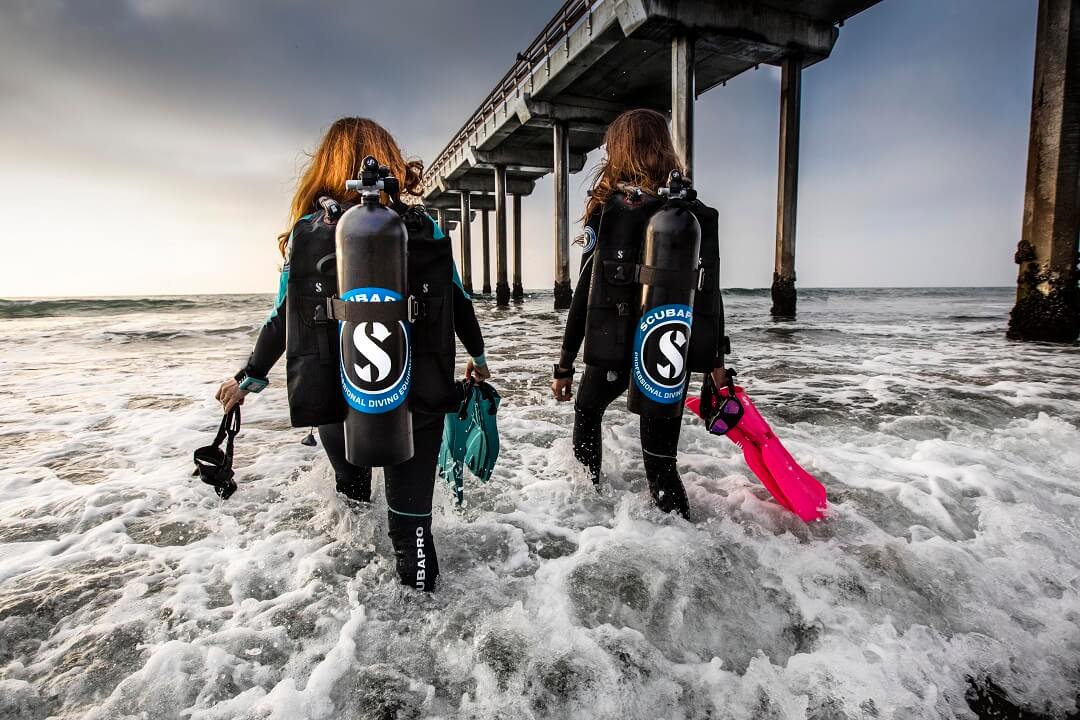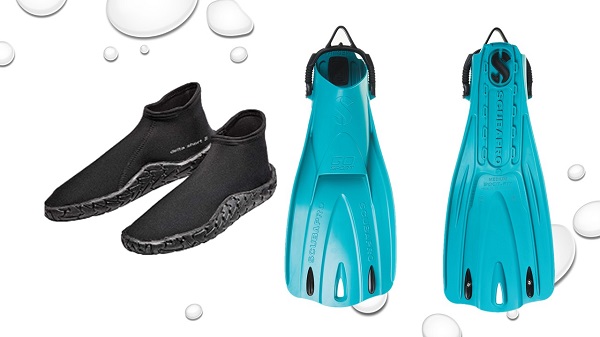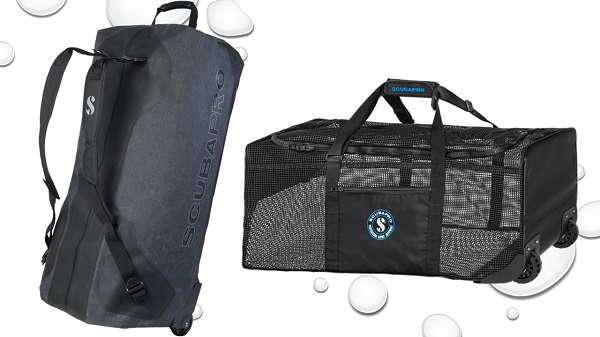Essential Shore Diving Tips
Shore Diving Done Right
Everyone loves a good boat dive, whether it's a day trip or a live-aboard adventure. That said, there is something special about shore diving. It's the luxury of driving up to the beach of your choice and diving on your own schedule. Plus, you get to explore some really interesting dive sites that you'd probably never see by boat.
But these good times don't just happen on their own. With boat diving you simply climb aboard with your dive gear and the boat crew does the rest to take you to the dive site. With shore diving, it takes some planning and a little know-how. Here are some things you can do that will increase the chances that your shore diving experience will be one to remember.

Shore Diving Tips – Before the Dive
Research the Proposed Dive Site.
While the best way to find out about beach diving sites is probably still by listening to recommendations from shore dive buddies, another good place to start your search for a worthwhile shore dive site is online. Chances are, if it's a good place to dive, someone else has already been there and has written a review or a summary of their dive experiences. These site reviews can give you an idea of the topography and marine life you can expect to see, where the best entry and exit points are, and if there are any hazards you need to be aware of. You can also get info on forecasted swells and water temperature. A good general resource for this is a website called shorediving.com. It offers tips on shore dive sites all over the United States, Canada, the Caribbean, and beyond.
Pick Your Time.
One of the benefits of shore diving is that you're not reliant on boat schedules. However, depending on where you are, your shore diving might be affected by the tides. Slack tide usually produces the best dive conditions. At slack high tide, the visibility is generally better, and entries and exits are easier. So find out when high tide is and plan on getting to the site right then. By the time you suit up and walk to the water, it will be slack high tide.
Evaluate the Conditions Upon Arrival.
When you get to the dive site, the first thing you want to do is take a walk down to the shore and see how the water looks. If there are waves, watch the surf for a while, get a feel for the sets and the lulls in between. If the surf looks iffy or is just too darn big, scratch the dive.
Gear Tips for Shore Divers
Shore diving often requires traversing stairs and/or rocks to get to the dive site's entry point. So first and foremost, bring durable Dive Boots with a good traction sole. This means you'll probably be diving with open-heel fins, even in warm water. The Go Sport is a good example of a compact open-heel fin that performs equally well in cold water and tropical conditions. Unless you're going to be bringing someone to stay on shore and watch your stuff, everything you bring will be going into the water with you, so everything not needed for the dive should stay in the vehicle except for the car key, which you can stow in a wetsuit inner key pocket or inside a BCD pocket if it offers a security clip.
Gear Up
You should be completely geared up with fins and mask in hand by the time you prepare to head down to the beach. Do your buddy check at the car or in the park, with emphasis on the Final OK. Nothing is worse than walking down three flights of stairs or over a rocky beach, get all the way out to the water, and then realize you left your mask sitting on the roof of your car or at the park.
Surf/Surge Entries – Get to the waterline and watch the surf or the surge. With your mask on and fins in hand (with straps already adjusted), wait for the lull in between sets to make your entry. It is important to get out of the surf zone as soon as possible. Get to about chest deep water and turn to face the beach and use the Figure 4 to put on your fins while keeping an eye over your shoulder on the surf. Stay close to your buddy during the entry. If one of you is having a problem, the other can help stabilize while fins are being pulled on.
If entering off a rocky beach with surge, time your entry to when the surge rolls in; that way you can ride the surge out as it recedes. Tip: If you are bringing a camera or a dive light that won't fit in your BCD pocket, clip it to something – a retractor or a D-ring. You might think you have an iron grip, but getting hit with even a moderate-sized wave or losing your balance on a surge entry can prove you wrong.

Shore Diving Tips – After the Dive
Exiting the Water.
On your way back in from your dive, make sure to surface well before you reach the surf zone. Inflate your BCD and swim towards shore while watching the surf. Gauge the sets and get a feel for when the next lull is going to occur. When it does, stay close to your buddy and swim towards shore. When you get to chest deep water, remove your fins and quick-march out of the water, keeping an eye peeled over your shoulder for any breakers looking to sneak up and embarrass you.
When making a surge exit over rocky terrain, reverse the procedure you used for entering the water. Ride the surge in, grab hold of the rocks while the surge recedes, then remove fins and get up and out of the surge zone as quickly as possible.
Another Dive?
If you're doing multiple dives and you have a long hike or lots of stairs between you and your car, it's not a bad idea to take off your BCD and set it down, preferably in a non-sandy area, making sure to keep your regulator and octo out of the sand. Remove the BCD and haul just the tank back to your vehicle to swap it out for a fresh one. Not having to make the trip hauling a wet BCD (especially if you're diving in cold water) will save time and a lot of energy you're going to need for your next dive.
Finishing your Dive Day.
There are two things you should never go shore diving without. One is a mat to stand on while changing out of your dive gear. Standing on wet, dirty and sometimes extremely hot sand, rocks or asphalt while barefoot is no fun at all. Secondly, make sure to bring some fresh water to first rinse yourself and then your gear. Who knows, you might want to stop for a meal before heading home or returning to the hotel. A good after-dive body rinse makes the rest of the day just that much more enjoyable. Tip: If you are diving at night or during cold weather, heat your rinse water. Before leaving home, fill your water jug with really hot water. By the time you finish your dive the water will be warm and feel good when rinsing off.
Dealing with Wet Gear.
If you don't have a truck bed or waterproof-lined car trunk, how do you get your wet gear home without leaking salt water everywhere? After doing the initial gear rinse, one way is to throw everything in a plastic storage bin. Or, if you need to be more mobile, a dry bag like the Dry Bag 120L Roller Backpack will keep wet gear contained, plus when you get to your destination the bag's roller wheels and backpack straps make for easy gear transport. On the other hand, if keeping your truck bed dry isn't an issue, you can take the opposite path by loading your gear into a mesh bag, preferably one with roller wheels like the Mesh 'N Roll. It's lightweight and ultra-durable, plus it allows you to tow your soggy gear behind you rather than letting it drench your backside as you head back to your home or hotel room.

Best Shore Diving Locations.
California
The Golden State's northern end of its Central coast has some fantastic shore diving, especially in areas around Monterey. These sites include Point Lobos State Natural Reserve, Monastery Beach and the Breakwater. In Southern California you have lots of choices, primarily along the rocky coastline of Laguna Beach and even farther south off the beaches of La Jolla.
Florida
Shore diving in Florida is popular all over the Sunshine State, but the best shore diving in Florida can be found along the mid to lower portion of the eastern coast. There you'll find Florida shore dives sites like the artificial reefs of Vero Beach, the natural reefs of Deerfield Beach, reefs and wrecks at Lauderdale-by-the-Sea and the unique experience of diving Blue Heron Bridge at Riviera Beach.
Hawaii
Shore diving in Hawaii is an experience not to be missed. You can find superb shore diving sites virtually anywhere in the Aloha State. Offering shore diving opportunities far too numerous to list here, focus your search on the leeward sides of the islands for some first-rate Oahu shore diving as well as on Maui, the Big Island and Kauai, and you won't be disappointed.
Bonaire
Known as the premier shore diving location in the world, this is probably the only destination you'll find where divers come specifically to shore dive. That's because with Bonaire shore diving there are so many sites to choose from, the water is warm, the visibility is incredible, and the underwater sites need to be seen to be believed. Plus, Bonaire dive operators make it so easy. Simply rent a truck, grab your gear and some tanks and hit the road. You don't need a map; each beach diving site is marked by a yellow rock with the site's name painted on it. It's easy, fun, and the diving is fantastic. Click here for more information.
Curacao
Curacao shore diving, while somewhat overshadowed by its neighbor Bonaire, still holds its own as a shore diving destination. Shore diving in Curacao offers a number of primo dive sites, the majority of which are on its leeward shore, most have easy entries and exits, and require only a short kick to reach some fabulous reefs offering lots of variety.
Roatan
Honduras' most popular dive destination, shore diving in Roatan presents a bevy of opportunities that can be found in two distinct sections of the island: south-side mid-island, and on the more rugged northwest coast. The reefs are relatively close so shore diving is readily available; however, most shore divers tend do their shore diving straight off the beaches of their dive resorts. Depending on where you are, expect to find lots of sea life plus some accessible wrecks.
St.Croix, USVI
You can find good shore diving on the island of St. Croix in the U.S. Virgin Islands. While there are a couple of nice spots on the west side of the island, the north shore is where the bulk of St.Croix shore diving action can be found.
Grand Cayman
Some great diving can be found right off the beach on Grand Cayman. Virtually all of the popular spots are conveniently located in front of the numerous dive resorts lining the western end of the island, either around Georgetown or farther up the road at West Bay.
So Go on a Shore Dive!
As you can see, there are hundreds of fantastic shore diving opportunities awaiting you all over the world. So don't worry about missing the boat – take the shore diving route instead. Strap on those fins and hit the water – some incredible adventures await!






